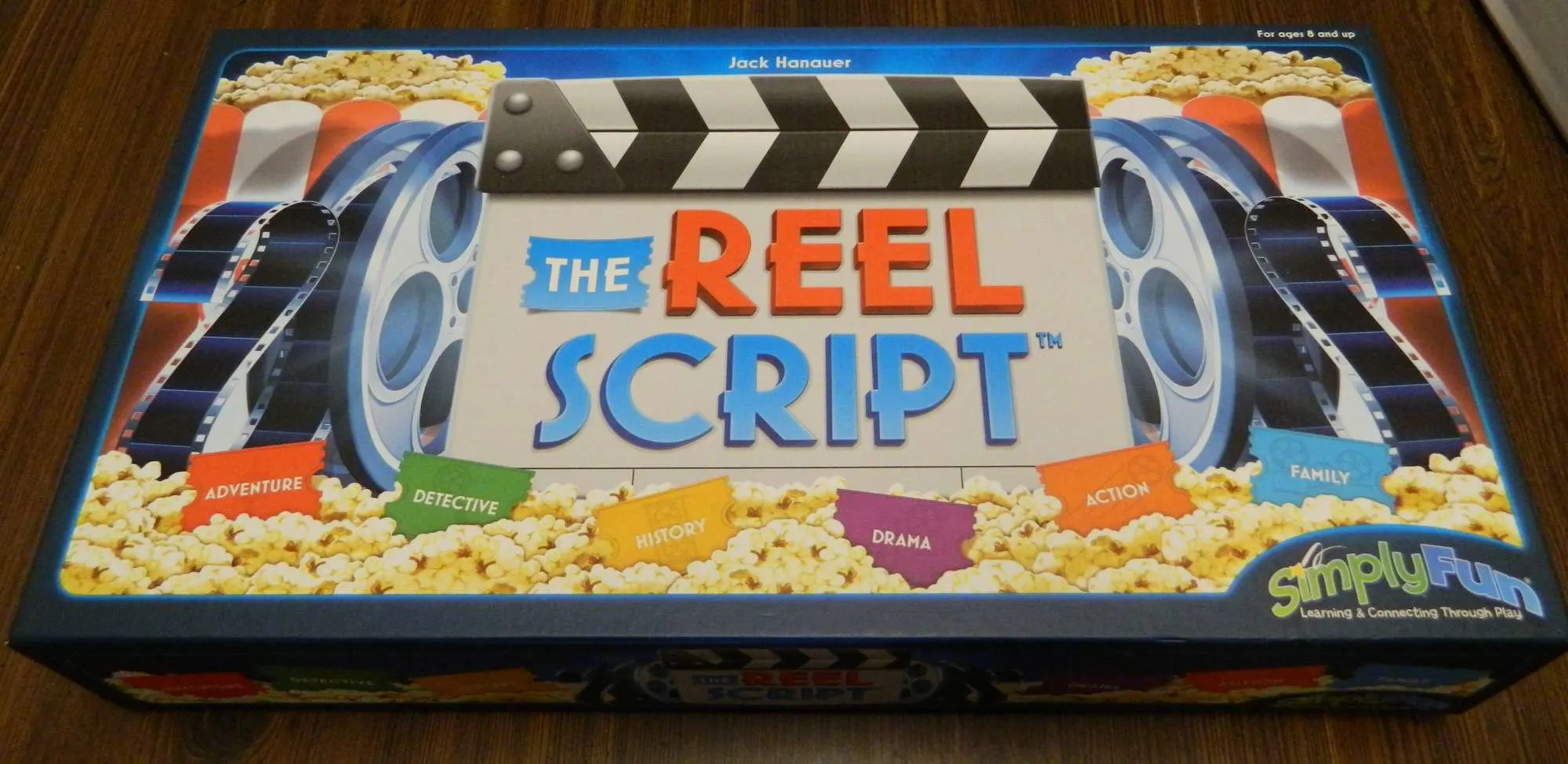We at Geeky Hobbies would like to thank SimplyFun for the review copy of The Reel Script that was used for this review. Other than receiving a free copy of the game to review, we at Geeky Hobbies received no other compensation for this review. Receiving the review copy for free had no impact on the content of this review or the final score.
How to Play
Objective
Acquire the most points after two rounds.
Setup
Each player takes a screen, bidding board, and movie reel of the same color along with 20 bidding (popcorn) tokens, and one voting token. Set up the game board in the middle of the table and place each player’s movie reel on the starting space. Shuffle all of the script line ticket categories together and give five cards to each player face down (players can look at their own cards).
Order of Play
The Reel Script is played in two rounds. Each round consists of three stages: bidding, pitching and scoring. A game will proceed in the following manner:
- First bidding stage consisting of two bidding rounds.
- First pitching stage.
- Score tallying.
- Second bidding stage consisting of two bidding rounds.
- Second pitching stage.
- Final score tallying and determining ultimate winner.
Bidding
Each round begins with the bidding stage. In the bidding stage the players will bid on cards to add to their hand. Each player will have twenty bidding tokens to use in order to win script line tickets. Eight cards are randomly drawn from the draw pile with one card being added to all eight numbered spots on the game board. Players look at the cards and decide which cards they would like to bid on. Players use their bidding boards (hidden behind their screen) to place bidding tokens on the numbers corresponding to the cards that they would like. Players can choose to use as many of their bidding tokens as they would like keeping in mind that there will be another group of cards to bid on so they might not want to use all of their bidding tokens in the first round of bidding.
After everyone has placed their bids, everyone reveals their boards. Starting with the first card, the card is given to whichever player bid the most for the card. The player who won the card gives up the bidding tokens used to purchase the card. Any player who lost the bid gets to keep the tokens they bid so they can use them on the next set of cards to be revealed. If no one bids on a card, the card gets discarded. If two players bid the same number of tokens, the player with less points will win the tie (not applicable in the first round). The second tie breaker goes to the youngest player.
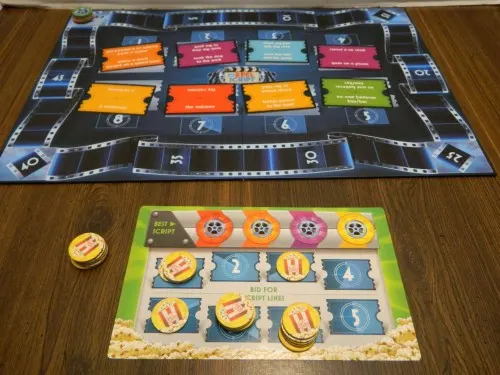
Pictured below is the bidding board for the green player. The green player likes the #1, #6, and #7 cards since they placed several tokens on those spaces. The green player also placed a token on the #3 and #8 card.
After the first eight cards have been auctioned off, eight additional cards are added to the board. Another round of bidding is performed. Players can only use the bidding tokens that they didn’t spend in the first round of bidding.
When the game returns to the bidding stage after completing the pitching and scoring stages, all players get back all twenty of their bidding tokens.
Pitching Scripts
Once everyone has gotten their cards from the bidding rounds, players move onto creating a movie pitch. In this stage players try to find a way to combine the cards in their hand in order to create a script/pitch that describes the plot of a movie. Each card can only be used once in the pitch and a max of ten cards can be used. Players do not need to use all of the cards in their hand for their pitch.
To help with making the pitches flow better, players are allowed to add up to two words between each card in their script. Players are also allowed to change the verb tense of words on their cards in order to make the pitch grammatically correct.
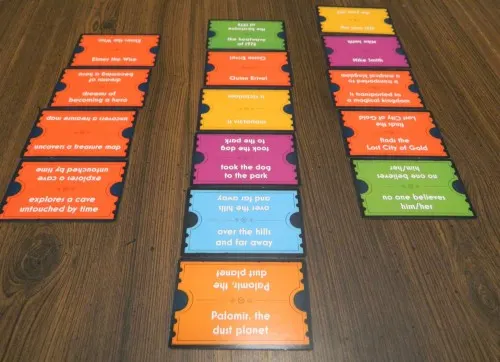
Here is an example of three different scripts that a player could make in The Reel Script. Starting on the left: “Elmer the Wise dreams of becoming a hero after uncovering a treasure map while exploring a cave untouched by time.” The middle script is as follows: “During the heatwave of 1976 Quinn Erivel is victorious in taking the dog to the park over the hills and far away to Palomir, the dust planet.” The right script is as follows: “In the year 1535, Mike Smith is transported to a magical kingdom where he finds the Lost City of Gold but no one believes him.”
When everyone has finished their pitch, they read their pitch to all of the other players. The players then use their bidding board and voting token to pick which script they thought was best. Players cannot vote for themselves. Whichever player gets the most votes is voted the best script and will receive bonus points (see scoring section).
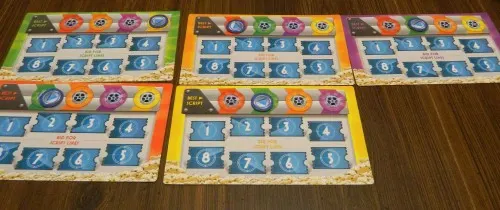
After a pitch round all of the players voted. The green player received three votes while the yellow and red player received one vote.
Scoring
After pitching their scripts, players’ scores will be tallied. Players will score points based on the number of cards and variety of colors used in the pitch. If all of the cards used were of the same color, the player will receive three points for each card used. If a player uses at least one card from all six card colors, the player will receive two points for each card used. If the player’s cards are not all the same color and all six colors were not used, the player will receive one point for each card used.
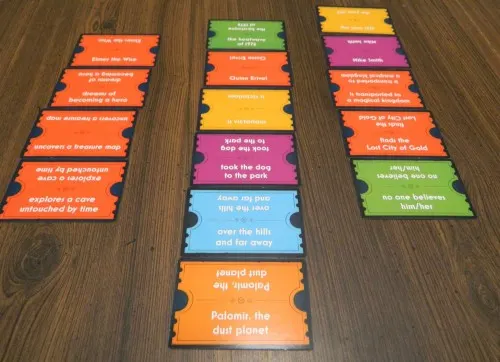
The script on the left features four cards that are all the same color which would score three points each for a total of twelve points. The middle script features one card of every color which is worth two points per card for a total of twelve points. The right script neither features only one color nor has all six colors so each card is only worth one point for a total of five points.
The player who had the best script will receive 15 points and each player that voted for the winning script will receive five points.
End of Game
After two rounds of bidding and pitching, the game ends. The final scores are tallied and whoever has the most points wins the game.
Review
We here at Geeky Hobbies are fans of the game Apples to Apples and other similar party games. While some of these games are better than others, we are always ready to try new games in the genre to see what they add to the formula. Also being a fan of movies, I was excited to give The Reel Script a try. While The Reel Script is not perfect, it does a good job creating an atmosphere for creativity that is fun for children as well as adults.
Making A Pitch
The main mechanic in The Reel Script is creating your movie pitch. When I first heard of The Reel Script this is the mechanic that interested me the most. Being a fan of other party games like Apples to Apples, I was really interested in how this mechanic was going to work. While it doesn’t work as well as it does in Apples to Apples, it is still quite a bit of fun.
One of the big themes of the game is imagination/storytelling. The Reel Script does a great job in this area. In order to excel at the game you really need to think outside the box and use your creativity since you rarely will get a bunch of cards that work neatly together. You need to look at the cards in your hand and start to form an idea of what you want to do with your story. You then use the bidding rounds in order to get the cards that you need in order to flush out your story idea. I could see The Reel Script being used as a good teaching tool to help stimulate creative thinking/writing.
What I like about The Reel Script is that while it is easy to play, it also has some strategy and opportunities to let your creativity shine. The game has a recommended age of 8+ and that is probably about right as long as the kids playing have solid reading skills. A kid that struggles with reading may have a little trouble with the game since you need to be able to read all of the different cards and understand what is written on them. Otherwise I don’t see kids having any problems with the game since the rules are so simple. You can read the instructions in just a couple minutes and teach it to new players in almost the same amount of time.
While the game is easy to pick up and play, the game has enough strategy to it to keep adults and children both interested in it. If you don’t like party word games like Apples to Apples you won’t like The Reel Script but if you like Apples to Apples I think there is a strong possibility that you will also enjoy The Reel Script.
What I like most about the pitching stage is that while it requires creativity in order to come up with your pitch, there is also a decent amount of strategy behind the scenes. Most of the strategy comes from what cards you bid on to add to your story. What I really like about the scoring system is that you are given points based on what types of cards you use instead of just how many cards you use. This encourages players to try and strategically bid on cards that will help them score more points.
Generally you are probably going to want to go for cards from all six categories. While it would be nice to use just one color in order to score three points per card, I don’t see this happening very often. Unless you didn’t shuffle the cards very well, it is likely that you will only get two or three cards of the same color with your initial cards. Add in the two to four cards that will go up for bid and you will likely only have up to seven cards of a color in play for a round. Several of these cards will be of the same function so you only have a couple cards that you could realistically use to form a story. The odds of you being able to play enough cards of the same color to make a coherent story is unlikely. The closest anyone got to using just one color was one player that had a three card story which didn’t really make any sense so they never played it.
Therefore you are better off just trying to use all six categories so you can get two points per card. Getting two points per card is a big advantage over only getting one point per card. If you are unable to have at least one round where you score two points per card, you are unlikely to win the game. This means that the bidding rounds become quite important as you try to acquire the colors you need in order to even attempt to create a story using all of the colors.
The only problem I really had with the pitch process is that like a lot of Apples to Apples style games, you will run into scenarios where none of the cards really work together. While making scripts you will sometimes make some great pitches that would actually be films that you would be interested in watching. Unfortunately you will have just as many pitches that are either really boring or don’t make any sense. Luck comes into play quite a bit here since if you end up with a bunch of cards that won’t work together you don’t really have much of a chance at winning. This is disappointing since you may have some rounds where only one player was able to even make a halfway decent story. This makes the voting phase kind of boring when there is an obvious winner.
The reason this mechanic doesn’t work as well as it does in Apples to Apples is because you need to play so many more cards in The Reel Script than you do in Apples to Apples. In Apples to Apples you have multiple cards in your hand and you only have to play one card at a time so it is likely that you will have a card that at least somewhat works. In The Reel Script you need multiple cards that work together or you will have a script that makes no sense.
While I wish more of the scripts would turn out better, I still had quite a bit of fun playing The Reel Script. People who like party games with this style of gameplay will probably like The Reel Script quite a bit.
Bidding
While the bidding mechanic is nothing new I think it works well in The Reel Script.
What I liked most about the bidding was that it is all silent bidding. This way no one knows what anyone else is going to bid so you need to bid enough to actually win the card while avoiding bidding too much and wasting chips. One of the things I don’t like about auctions in most games is that there is no suspense since players will generally raise the bid by one until all but one of the players drop out. What I like about the silent bidding is that you need to try and bluff your opponents while also trying to determine what cards they will try to go after.
There is actually a decent amount of strategy to the bidding itself. Since everyone has the same number of tokens to use, everyone will be able to get some script cards. How you decide to use your tokens matter though. You could decide to key in on a couple cards that will really help your script. In order to get the cards you will need to bid somewhat high on the cards. Otherwise you could try to bid on quantity. With this strategy you bid low on all of the cards which will allow you to pick up a bunch of cards that the other players didn’t want. Since you don’t have to use all of the cards from your hand, this strategy can give you a lot of options if you don’t have a good idea of what you want to do with your story when bidding starts. Outside of the rigged tie system (see below) I think either strategy is valid.
The Tiebreaker Could Easily Decide the Game
Generally the tie breaking systems in board games are usually not very good. Since it doesn’t pay to make a tie breaking system very complicated, they generally come down to luck. While The Reel Script’s tie breaking system doesn’t rely on luck, it could use a lot of work.
How The Reel Script is set up, there will likely be quite a few ties in the bidding rounds. I would be shocked if you went through a bidding round without at least one tie. The first tiebreaker in The Reel Script is who has the least amount of points. This makes a lot of sense since it helps players who are trailing catch back up. The problem is that this only applies to the second round of the game since no one will have any points in the first round so every tie will go to the second tiebreaker which is age. The youngest player will then win the tie. This is a good idea if you are playing with younger children since it will help them stay in the game.
The two tie breaking mechanics themselves aren’t bad ideas except for the fact that there are so many ties in the bidding rounds. If only one or two ties were broken with these mechanics it wouldn’t be much of an issue since it would slightly favor the younger players and the players who are furthest behind. Unfortunately in one round of bidding, one player ended up winning at least four or five cards solely by tiebreakers which gave the player a significant advantage. As a matter of fact that player ended up winning the game because of the ties since the player only won by two or three points and if they wouldn’t have won two of those ties they would have lost.
The Reel Script really needed a way to allow any player to win some tie breakers. For example at the beginning of a bidding round the player with the least points/youngest should have been put first in the tie breaking order. When a tied bid would come up, whoever was highest in the tie breaking order would then be given the choice to break the tie. If they decided to take the card they would then move to the bottom of the tie breaking order which means they wouldn’t win the next couple of ties. If the player chose not to take the card they could stay in the same spot in the tie breaking order so they could win a tie on a future card. I am guessing that The Reel Script chose not to do this because it might have added quite a bit of complexity to the game. The next time I play The Reel Script though I plan on adding a tie breaking system like this.
Vote With Your Heart
One of the biggest problems with games that require players to vote, is that players can easily cheat in order to improve their chances of winning. Since the votes have a direct impact on who ends up winning the game, a highly competitive person could easily cheat in order to win the game. Since the voting is subjective, if a player wanted to really win the game they could purposely vote for a player that is behind them in order to prevent another player from beating them.
Unfortunately this problem is not solved in The Reel Script. While the problem is not as bad as in games that rely solely on voting, it has a significant impact on who ultimately ends up winning the game. While creative use of your cards can lead to quite a few points, you will generally score at max sixteen points on a turn. Since the winner of the vote receives fifteen points plus whatever they scored from the cards played, whoever is voted the best scriptwriter in a round will get the most points in that round.
The Reel Script does try its’ hardest to fix this problem. While I don’t think players should get points for just picking the script that the most players end up voting for, I like that it helps try to solve this problem. Since players will get some points for being honest and picking the script that they felt was best, I think players would be more willing to actually vote for the best script.
Due to this problem though players need to really play honestly or they will ruin the game. The Reel Script is not the type of game that you want to play with a player that is really competitive and always needs to win. This is the type of player that is most likely to cheat and vote for a player just so they are able to win the game. The Reel Script will work best in an environment where everyone just wants to have some fun and no one really cares who ends up winning the game. If everyone can vote honestly, this problem eliminates itself.
Very Nice Components
When I think of SimplyFun games I always think of high quality components and that is no different in The Reel Script.
While a lot of the artwork is pretty simplistic I think it works well for the game. The game does a good job making it easy to know where everything is by eliminating a lot of clutter that a lot of games would have added. The Reel Script just focuses on what is important so you don’t have to waste time trying to find what you are looking for. This is shown most clearly by the player screens. While the outside of the screens have some pretty nice artwork, the side that faces the player shows a quick roundup of all of the rules, including three examples showing how scores are calculated at the end of a round. If you ever forget a rule you can just quickly reference your player screen.
Other than being designed well, the components are made of high quality components. The cardboard pieces are made of the typical thick cardboard that SimplyFun uses for all their games. The game should last a long time as long as it is taken care of.
The only real complaint I have with the components is that it only includes components for five players. I see The Reel Script being a game that could work well at parties so I it would have been nice if it supported more than five players. If you end up playing the game with a large group you will just have to either divide into teams or make your own components for the extra players.
Final Verdict
While not as good as Apples to Apples, I thought The Reel Script was a good party game in the same vein. The game is accessible to children (as long as they have solid reading skills) but also provides enough strategy/creativity in order to keep adults interested. The game can be especially enjoyable when you can come up with a good script for a movie that you would actually want to see or a script so strange that it makes you laugh. Unfortunately there are also quite a few situations where the cards just don’t work together and you end up with quite a few boring/nonsensical movie ideas.
If the theme or the party game mechanics don’t interest you, you probably won’t like The Reel Script. If you do though I think you should enjoy The Reel Script. I also see The Reel Script working really well as a creative writing/thinking exercise for children.
If you would like to purchase The Reel Script you can purchase it directly from SimplyFun.com.

